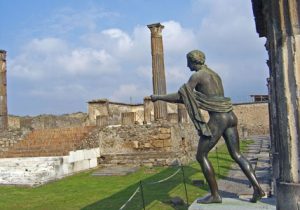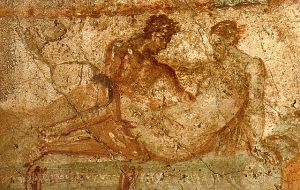By Chris Millikan
 A day trip from Naples, Italy introduces us to one of Europe’s best-preserved archaeological sites. The catastrophic eruption of Mt. Vesuvius in 79 AD entombed Pompeii under six meters of volcanic ash. Entering this sophisticated Roman trading metropolis through ancient Porta Marina.
A day trip from Naples, Italy introduces us to one of Europe’s best-preserved archaeological sites. The catastrophic eruption of Mt. Vesuvius in 79 AD entombed Pompeii under six meters of volcanic ash. Entering this sophisticated Roman trading metropolis through ancient Porta Marina.
Massimillio guides us toward the main city square, gesturing widely, “Visualize bakers, merchants and aristocrats from nearby neighborhoods patronizing this marble-paved Forum!” He points out what were law courts, bustling shops and eateries. Of the surrounding lavish temples, a single statue defines one end of the Temple of Apollo; an intact marble staircase delineates the Temple of Jupiter.
Elegant homes mingle with smaller houses along Via de la Fortuna. At House of the Faun, a forest sylph welcomes us into its open courtyard. This grand mansion belonging to wine merchants had forty stylish rooms, including four magnificent dining rooms, one per season. Carved columns line two immense gardens, once filled with statuary and fountains. Nearby, the House of the Vetti boasts original mosaics in green jade, white marble and indigo-blue onyx; vibrant frescoes decorate entertainment rooms. A small house next door features earth-tone frescoes of flowers and whimsical fairies, my favorite.
Encountering a 2000-year-old lead pipe prompts Massimillio to explain, “From an aqueduct-fed tank, three systems supplied water to all public baths, homes and fountains. During droughts, only main fountains operated. At the next intersection he adds, “Locals met daily at public fountains, exchanging news and views.” Continuously overflowing, fountains flushed streets and gutters; elevated steppingstones allowed pedestrians to cross the flooding streets.
Raised sidewalks lead us toward one of 34 bakeries feeding Pompeii’s population of 20,000. Imagining tantalizing aromas wafting on air, we marvel that their brick ovens so closely resemble today’s pizza ovens. “During excavations, centuries-old loaves of blackened breads were found inside many,” grins Massimillio.
Beyond, a mosaic bear holding its head announces Taberna Hedones, a tavern of high living self-indulgence. The marble buffet that kept foods hot still stands out front. Stalls selling wine, cakes, nuts, figs and bread once lined these streets.
 Crossing steppingstones to the red light district’s top lupanare, we join other curious visitors cuing to view faded erotic frescoes and discover that multi-lingual clientele used these depictions to select preferences. Inside, surprisingly small ‘cells’ held stone beds covered with mattresses. Wealthier clients used second-story rooms bedecked with fancier frescoes leaving little to the imagination.
Crossing steppingstones to the red light district’s top lupanare, we join other curious visitors cuing to view faded erotic frescoes and discover that multi-lingual clientele used these depictions to select preferences. Inside, surprisingly small ‘cells’ held stone beds covered with mattresses. Wealthier clients used second-story rooms bedecked with fancier frescoes leaving little to the imagination.
Pompeii’s citizens relaxed in three public baths. At Stabian Thermae, men and women played endless games of knucklebones amid erotic frescoes in reds, greens and gold. Heated water running through wall cavities warmed rooms decorated with elaborate mosaics and bawdy sculptures.
First built in the 2nd century BC, the Grande Theater seated 5000 patrons; a smaller semi-circular neighbor, the Odeon staged mime and music. From topmost hillside seats, we spy gladiator barracks and the colonnaded courtyard beyond. According to Massimillio, gladiator-slave extraordinaire, Spartacus had trained here… but fought in the 12,000-seat amphitheater ten minutes away.
Just as in days of old, Pompeii again attracts thousands of foreigners annually.
About the Author:
Chris Millikan is a freelance writer/photographer living near Vancouver, BC. As a former teacher and elementary school principal, Chris now presents articles as an inviting ‘curriculum’ depicting the joys of travel. Many BC community newspapers, Open Road Driver Magazine and Senior Living Magazine regularly publish her articles. In-flight Magazines, the Vancouver Sun and Province have also featured her stories. As BC Association of Travel Writers Vice President, she supports colleagues’ aspirations. And traveling off the beaten track with writer/photographer partner and hubby Rick, their published tales reflect great adventures. Their 2009 Kalama Award acknowledged an array of their stories reflecting the rich culture of Maui, Molokai and Lanai.
Leave a Reply